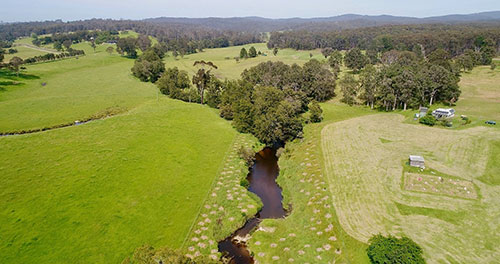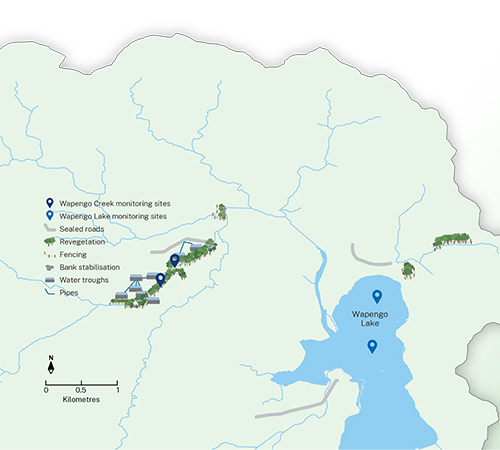MEMS case study - Wapengo Lake catchment
Community action to restore Wapengo Lake catchment
Local landholders are leading efforts to rehabilitate Wapengo Lagoon and its major tributary Wapengo Creek, with support from South East Local Land Services (LLS) and the Department of Planning and Environment (DPE). The projects are aimed at improving and maintaining a high standard of water quality to support the community and the thriving local Wapengo oyster industry. Funding for the projects is provided by the NSW Government under the Marine Estate Management Strategy (MEMS), a 10-year strategy to coordinate management of the marine estate.

Riparian vegetation planted along Wapengo Lake catchment waterway.
What is being done?
Landholders are replanting riparian vegetation. The trees and shrubs that line the fringes of waterways along their properties to minimise bank erosion and reduce the amount of sediment and nutrients that run off into the lake.
Landholders are also installing fencing to exclude their livestock from entering Wapengo creek. This also helps to minimise bank erosion, as well as to prevent animal wastes from washing into the waterway. Faecal bacterial contamination is a major issue affecting oyster production throughout the state.
LLS and Bega Valley Shire Council are sealing dirt roads adjacent to the lake and creek, as they can be source of sediment entering the waterways during rainfall events.
Improvement over time from better to best
DPE scientists have been assessing several key environmental indicators at Wapengo Lake and Wapengo Creek to understand the overall health of the waterway and the downstream benefits of the works.
Water quality at Wapengo Lake is excellent. Concentrations of microalgae and nutrients are low, and water clarity is good. The surrounding catchment remains mostly forested and undisturbed, including national parks and reserves.
Wapengo Creek is in relatively fair condition with slumped and eroded stream banks, and the presence of faecal bacteria. The health of Wapengo Creek could be improved to protect the natural and economic values of the lake
downstream, such as maintaining the quality of the prized local oysters. Fencing will reduce grazing pressure on the riparian vegetation along the creek and will reduce faecal matter being washed into the creek.
Restoration work completed
- 5 km fencing along the creek
- 3,750 native trees and shrubs planted
- 150 metres of riverbank stabilised
- 3 km of dirt road sealed adjacent.

Location of Wapengo Lake catchment riparian vegetation improvement works and monitoring sites.
Timeline of recovery
Over time we expect to see creek banks stabilised by the riparian vegetation, less erosion, more habitat and shade along the creek, and greater diversity of frogs, fish and water-bugs. Livestock exclusion from the creek will see improvements to ground cover, bank stability, instream vegetation, and lower bacterial and nutrient levels in the water.
Why should you get involved?
There are many benefits of rehabilitating the riparian zone. Not only is it good for the environment in the long run but these works provide social and economic benefits for you and your land.
Get in contact to find out more about restoring the riparian zone on your property, including fencing works, water troughs and planting riparian vegetation.
Download a PDF copy of the Wapengo Lake catchment case study PDF, 751.78 KB.
For more information
Leanna Moerkerken, South East Local Land Services
E: leanna.moerkerken@lls.nsw.gov.au
P: 0427 291 798
These projects are funded by the NSW Government under the Marine Estate Management Strategy. The 10-year Strategy was developed by the NSW Marine Estate Management Authority to coordinate the management of the marine estate. Visit the NSW Marine Estate website to find out more.

